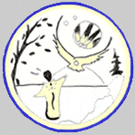![]()
|
Frontier School Division |
 |
||||
 |
 |
 |
 |
|
 |
 |
 |
 |
|
| Return to Homepage | ||||
|
SSNS Home > Home & Community > Aboriginal Roots > Frontier Sources > Frontier Families > Nabaise
Nabaise Vqh [Naa-pay-s][1]Researched by Frontier School Division
Summary Nabaise Vqh [Naa-pay-s] is a surname that may have originated southeast of York Factory in the region about Trout Lake.[2] The first man to bear the name was of mixed Northern Ojibway (or Cree) and European background, born circa 1795, according to his baptismal record at Norway House in 1843. The name given to him by the missionary James Evans was “Mark” Vqh [Naa-pay-s], although there is evidence suggesting he was also known as “John.” Mark/John had a son named John Nabaise, who was eventually associated with the Cumberland House Band. John had one son Donald Nabaise, who had at least three sons. More research is required to find out whether they have any descendants. There is another family named Nabess at Cumberland, The Pas, and Cormorant, but apparently it is unrelated. Mark/John Vqh [Naa-pay-s] probably only travelled to York Factory on occasion to trade his furs prior to 1810-1815, when such travel apparently ceased. By 1823, “Napish” was in the trade area associated with Oxford House, and he was listed in the census there that year with a wife, three sons, and a daughter. In the 1838 Census at Oxford House, “Nappaish” had a wife, two sons, and a daughter living with him, and three sons listed separately. Mark/John’s wife was baptised “Martha” by James Evans at Norway House in 1843, although there is evidence that she was also known as “Nancy.” Martha/Nancy was described as thirty-six years of age at that time, meaning she would have been born circa 1807. This would have made her sixteen years of age when the 1823 Census was taken, but evidence suggests that she was the mother of at least two of the older sons of “Nappaish,” who were probably listed on the 1823 census, so Evans may have underestimated her age. In that case, she could have been the mother of all of Mark/John’s children listed below.
The combined information from the census and church records suggest that Mark/John Vqh [Naa-pay-s] had five living sons and possibly two daughters. A question arises as to why two of those sons were named “John.” John Vqlh [Nah-pay-si-s], No. 1 above, was baptised by William Mason in 1844, while his brother John sVWnQt [Mi-nah-wee-way-t], son of “Mark” and “Martha” Vqh [Naa-pay-s], No. 2 above, was baptised by James Evans in 1843. The fact that brothers had the same Christian name is not all that surprising at the time. Since two different clergymen officiated at these baptisms, it is possible they inadvertently used the same name for both. However, each of the young men may have chosen the name John himself. When John [Mi-nah-wee-woo-t or Mi-nah-wee-way-t) Nabais applied for “Half-Breed” scrip in 1887, he listed his parents as “John and Nancy Nabais.” If these were in fact the real names, and the names “Mark” and “Martha” arbitrarily chosen by the missionaries, then it is quite possible that two sons would have chosen to be named after their father.
For more information, see the following Evidence:
Click on the footnote number to return to the text. [1] The syllabics are more correctly written with a dot over the first symbol. The “aa” sound is like the “a” in cat. [2] The evolution of “Nabaise” in Hudson’s Bay Company records is an important clue concerning the origins of the first man to bear that name. Between 1810 and 1823, “Nappish” (or variant forms such as “Na pish”, “Nappaish” and “Napesh”) prevailed, but between 1827 and 1830, “Napis,” and “Nabaise” were more often used. Then, there was a return to variants of Nappish during the 1830s and early 1840s, followed by another shift back to Napis and to Nabaise, which became the final form. The subtle change from “sh” in “Nappish” to “s” in “Napis” probably reflected a linguistic shift from the “sh” typical of Northern Ojibway or Oji-Cree to the “s” found in Cree. This is evidence that Napish was Northern Ojibway or Oji-Cree, or at the very least had lived among them long enough to have that fact show up in his name. He traded at York Factory as early as 1810, but he was not from there. In fact, in 1814, he was reported at Trout Lake in Northern Ojibway or Oji-Cree country far to the southeast, suggesting that this was where he originated. However, he lived among the Cree at Oxford House for many years after, and that influence was evident when his sons were baptised in 1840. James Evans gave them the Christian names of William and Peter, with the Cree form of Vqh [Naa-pay-s] as their surname. In all likelihood Evans, who was thoroughly familiar with Ojibway and Cree, transcribed the surname as he heard it, even though the Ojibway form still appeared in the HBC records at Oxford House after 1840, probably because that was the way it had been written in previous years. The syllabics provide the key to pronunciation. Ordinarily, the first syllabic V is written with a dot over it to reflect the sound “naa” (rhyming with “cat”). The second syllabic q sounds like “pay” with the raised final h sounding like “s” (thus, “pay-s” rhyming with “chase”). The shift from “Nap” to “Nab” occurred because non-speakers of Cree often heard “b” when a Cree speaker intended “p.” Non-speakers sometimes missed the subtle shift from “is” to “aise,” too. The spelling privileged in this account is “Nabaise” because that is the spelling that prevailed in the end.
Last updated: November 17, 2010
|
|
 |